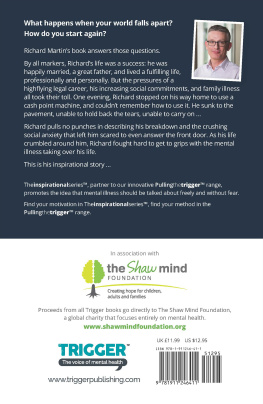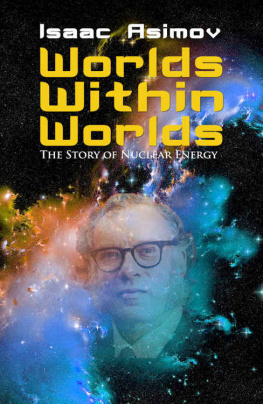SUPERFUEL
SUPERFUEL
THORIUM, THE GREEN ENERGY
SOURCE FOR THE FUTURE
RICHARD MARTIN


SUPERFUEL
Copyright Richard Martin, 2012.
All rights reserved.
First published in 2012 by PALGRAVE MACMILLAN in the United Statesa division of St. Martins Press LLC, 175 Fifth Avenue, New York, NY 10010.
Where this book is distributed in the UK, Europe and the rest of the world, this is by Palgrave Macmillan, a division of Macmillan Publishers Limited, registered in England, company number 785998, of Houndmills, Basingstoke, Hampshire RG21 6XS.
Palgrave Macmillan is the global academic imprint of the above companies and has companies and representatives throughout the world.
Palgrave and Macmillan are registered trademarks in the United States, the United Kingdom, Europe and other countries.
ISBN 978-0-230-11647-4
Library of Congress Cataloging-in-Publication Data
Martin, Richard, 1958
SuperFuel : thorium, the green energy source for the future / Richard Martin.
pages cm
Includes index.
ISBN 978-0-230-11647-4 (hardback)
1. Thorium. 2. ThoriumSeparation. I. Title.
TP245.T6M37 2012
669'.2922dc23
2011047557
A catalogue record of the book is available from the British Library.
Design by Letra Libre, Inc.
First edition: May 2012
Printed in the United States of America.
To Shawna, who listened and believed.
CONTENTS
Nature which governs the whole will soon change all things which thou seest, and out of their substance will make other things, and again other things from the substance of them, in order that the world may be ever new.
Marcus Aurelius, Meditations
INTRODUCTION
One day in June 2009, I hiked along the Clinch River in northern Tennessee to what was once supposed to be the site of the most advanced nuclear power plant in the world. With my companionsJohn Kutsch, the owner of an engineering design firm in Chicago; Bruce Patton, a scientist at Oak Ridge National Laboratory 30 miles or so up the road; and Kirk Sorensen, an engineer at the Marshall Space Flight Center in Huntsville, AlabamaI clambered over a dilapidated chain-link fence and walked down the dirt road that followed the meandering river. It was the first really steamy day of summer. The woods were loud with crickets and desultory birdsong, and a double-crested cormorant launched itself off the surface of the sluggish river. We were trespassing on federal property, but it seemed unlikely that anyone would care. We passed the foundation of an old guard shack covered in foliage. It was like the setting for a postapocalyptic movie, except we werent being pursued by zombies.
After a mile or so we came to a wide clearing on the inner curve of a horseshoe bend in the river. Obviously manmade, it was empty save for grass and gravel and a few arborvitae trees. Nothing stirred.
Eight billion dollars, said Sorensen. Thats what youre looking at.
What we were looking at was the abandoned site of the Clinch River Breeder Reactor. Planned in the 1960s, Clinch River was originally conceived as the prototype of a new class of futuristic nuclear reactors that would create more fuel than they consumed. The project officially began in 1970 and finally was abandoned in 1983, after innumerable studies, reports, and rhetoric, plus the eight billion dollars that Sorensen mentioned. Once advertised as the future of power generation in the United States, Clinch River is now synonymous with technological hubris and the failed promise of atomic power. We were standing in the graveyard of the U.S. nuclear power industry.
As we ambled back toward our cars, Sorensenwho at that time was studying for a masters degree in nuclear engineering at the University of Tennesseetalked about the folly of U.S. nuclear policy and about the little-known element that could transform it.
Thorium was the alternate path, he said. Its a safer, more abundant fuel that couldve revolutionized nuclear power. The problem is, it has almost nothing in common with what were doing now.
I was on assignment for Wired magazine, and that trip, which encompassed a round of interviews at Oak Ridge and a driving tour of the Tennessee Valley Authoritys extensive power-generation facilities, including the massive Watts Bar Nuclear Generating Station 25 miles or so to the south, was my introduction to the thorium power movement. This book is the outcome of the journey that started on that hot summer day in Tennessee.
Ive written for Wired for ten years, and Ive often joked that every story in the magazine has to use the word revolutionary. Thorium power actually seemed to justify that label. The more I learned about the lost history of thoriumespecially the successful creation of a thorium-powered reactor at Oak Ridge in the 1960s and the career of the Oak Ridge director Alvin Weinberg, who championed safe thorium reactors and lost his job for itthe more astonished and outraged I became. Here was an inexpensive, safe, abundant energy source that could power every city on Earth, with enough left over for hundreds of millions of electric vehicles, for several millennia. And we were sitting on it, essentially doing nothing. It was insane. And the small band of technologists I was traveling with that day seemed like the only ones who were actually trying to bring the technology back to life, with zero encouragement from the government and plenty of disdain from the nuclear power industry.
TH90 TH90 TH90
IN A WAY THIS BOOK WAS BORN not when I first saw a mention of thorium power online (in a guest post written by Charles Barton Jr., on the website The Oil Drum) but decades before, when I was in high school, backpacking in the Ozark Mountains of northwest Arkansas. I grew up in Little Rock, and my friends and I spent many, many weekends trekking through the Ozarks and camping in the thick forests that cover the deep gorges formed by the Buffalo River and its watershed.
For several years we went out every January 1 for a New Years backpacking trip. The Ozarks are spectacular in the winter. Daytime temperatures fall into the teens, the creeks are frozen over so the hiking is easy (but not so solid that waters unavailable), and sunlight glitters through the bare elms, oaks, and walnuts. The solitude and stillness are absolute. Downed wood is plentiful in the Ozarks, and at night we built bonfires. Sitting around the fire, surrounded by the dark and frozen wilderness, forces on you a powerful impression of the energy that sustains our fragile lives. Backpacking requires you to carry with you all the fuel to sustain you for the length of the trek for your camp stove, for your body, for igniting the energy stored in all that downed wood. Much time in the woods is spent calculating energy: How much should I eat now? How much wood do we need to gather? How much clothing should I wear to stay warm without sweating too much? How am I going to light my camp stove if my matches get damp? Will my flashlight batteries last?
Im an early riser in the wilderness, and I used to awaken in the zero-degree dawn to light the morning fire. Relight it, actually: I prided myself on being able to restart the fire from the previous nights still-glowing embers, rather than using a match. Thats when I began to wonder about energy. From where does it come? How is it that the glowing coals store their energy through the subfreezing night? Is energy infinitecould we ever burn all the dead wood this forest sheds? And so my thoughts ran until the sun came over the ridge and my companions emerged from their tents.
Next page















